FREE SHIPPING ON USA ORDERS OVER $150
July 25, 2016 0 Comments
Between the Bernharts’ household and mine, we own a lot of cookbooks. Both families love to cook, but I also often write about food, so I have a few quirky, specialized titles in my collection.
- A few cookbooks
- A few more cookbooks
- Must we say it again?
- Seriously though!
Take The Fabrication of Farmstead Goat Cheese, for example, or, better yet, The Apicus, a 4th-century collection of Roman recipes—fermented fish paste, anyone? Two weeks ago, our blog focused on The Food Podcasts We Love. This week, we thought we’d list a few of the cookbooks we turn to time and time again:

The Art of Simple Food: Notes, Lessons and Recipes from a Delicious Revolution
by Alice Waters
Chef, restaurateur, author and activist, Alice Waters, has (according to the New York Times) “single-handedly chang[ed] the American palate.” Waters would like to see us all cook more simply and healthfully, using as many seasonal and regional ingredients as possible. In her umpteenth cookbook, The Art of Simple Food, she discusses this a bit. Mostly, though, she focuses on teaching core culinary principles, from stocking your kitchen to keeping your knives sharp and using them properly. And she offers more than 200 recipes for the simple, sustainable dishes she’s known for. Encyclopedic and inspirational, The Art of Simple Food is a great primer for the beginner cook and an excellent refresher course for the seasoned gourmand.
Because Waters’ recipes call for so much fresh produce, we’re pretty sure she’d appreciate our large wooden bowls for gathering it all.

Hunt, Gather, Cook: Finding the Forgotten Feast
by Hank Shaw
First a disclaimer: The author of this book is a friend of mine, but I loved Hunt, Gather, Cook long before I met Hank Shaw—the man behind Hunter, Angler, Gardener Cook, a blog that’s about Shaw doing those very things. Whether you’d like to learn how to pluck a duck or render its fat, forage for mushrooms or dig for clams, Hank’s books, and his blog, are hands-on guides to living off the land and then cooking up the bounty from your endeavors. His recipes and how-to information are not only practical, they’re persuasive, making a life such as Hank’s compelling, even if it involves killing an animal in order to eat it, “the primary pursuit of humans,” he writes, “for more than a million years.” Hank’s personal and historical insights make this particular book (his first of three) that much more fascinating. In a section on foraging for Manzanita berries, for example, Hank writes, “the first European settlers of California made a sort of cider from the berries of the Manzanita bush. You'll find these bushes growing in great profusion in the Sierra Nevada of California”—an interesting tidbit that becomes relevant when he gives us that cider recipe.
We’re pretty sure our large spreader sampler is requisite for spreading all of the delicious pâtés and confits Hank instructs us to make in Hunt, Gather, Cook and on his website.

by Jamie Oliver
Okay, we all know the Naked Chef isn’t Italian, but he’s traveled the country countless times foraging, tasting, cooking and learning from grandmothers, winemakers, Napoletani pizzaiolis, and others. As a result of this research (Wait! Can we call this research? It sounds too fun!), Jamie’s Italy is a treasure trove of delicious, truly authentic (trust me) Italian recipes. No matter what region’s cuisine Jamie’s exploring, one of his goals is to make cooking fun and accessible. To that end, whether it’s a recipe for wild boar or schiacciata di manzo con aglio, rosmarino, e funghi (flash roast beef with garlic, rosemary and mushrooms), the instructions in this book are clear, down-to-earth and approachable. To boot (pun intended), Jamie’s Italy is beautiful with its gorgeous matte-finish pages and lush photographs. While perhaps a few too many of the photos are of Jamie posing with this Italian cooking icon or that village nonna, the man’s love for Italian cookery—and for the people of Italy—shines through, making this a great read and a mouthwatering guide to the country’s foods and culinary traditions.
For this cookbook, we’re pretty sure one must own a pair of l flat sautes for tossing the many delicious salads detailed here and a long server for scooping up generous portions of Jamie’s delicious Zuppa di baccala (salt cod soup).
July 12, 2016 0 Comments
When Brad is working at the Earlywood studio, he’s often listening to podcasts. When I’m cooking or cleaning up after cooking, I tend to do the same thing. We thought we’d give you a taste of some of our favorites from time to time, beginning with our favorite food podcasts.
But first, for those of you who may not be familiar with the term, just what is a podcast? Podcasts are, simply, episodes of a program available on the Internet. They’re usually original audio or video recordings, but they can also be excerpts or entire broadcasts from a radio program, a performance, a lecture or another event. Podcasts can be subscribed to for free and downloaded onto a device—a computer, cell phone or iPod—for offline listening. For a complete definition, check out this page at Wikipedia.
“The idea is to eat well and not die from it—for the simple reason that that would be the end of your eating.” That’s a quote from the late, great author Jim Harrison. I’ve wanted to share it for ages. This seemed as good an opportunity as any. We doubt Jim listened to podcasts, but if he did, we think he would have listened to these:
If you’ve never listened to Lynne Rossetto Kasper’s cooking show, broadcast by American Public Media, you’re in for a treat. First of all, she’s not only a walking, talking encyclopedia of food knowledge and recipes, she’s warm and delightful—an acclaimed food writer and celebrity chef, if you will, but never a food snob. Kasper interviews farmers, writers, chefs and others to lead people on a “journey of the senses” (her words) and celebrate all things culinary—from the culture of food to the science of it, the recipes to the histories. A lush listen, to be sure.
From Heritage Radio Network, this podcast features interviews of the individuals who “defied convention and shaped our food landscape.” Think Michael Pollan (of The Omnivore’s Dilemma and Cooked fame), Frances Moore Lappé (author of Diet for a Small Planet—published in 1971, it was among the first books to link world hunger to our own food choices) and Alice Waters (the founder and owner of the San Francisco eatery, Chez Panisse, who built a career on the notion that cooking should be based on ingredients that are produced seasonally and locally—and in the process helped start a movement). This podcast may not make you hungry, but it will make you think.
When it comes to understanding the science behind cooking, we turn to America’s Test Kitchen—a real, 2,500 square-foot kitchen where the staff will test a recipe “30, 40, sometimes as many as 70 times” until they get it just right. The kind of obsessive we like, ATK is the podcasts for food geeks.
Hosts Andrew Zimmern (from The Travel Channel's "Bizarre Foods") and Molly Mogren (world traveler and self-described “food fanatic”) have been on hiatus for some time now, but digging into the archives of this show is worth it, if you can get over the cheeky name. Whether the duo is discussing the food of Kazakhstan or interviewing a James Beard award-winning cookbook author, they’re funny, informative and, like the podcast’s name, not just a bit irreverent.
Another Heritage Radio gem, Eat Your Words is a great guide to the contemporary literature of food, featuring interviews with authors of cookbooks, food memoirs, travelogues and food industry exposés.
Host Linda Pelaccio is a culinary historian who conducts fascinating interviews of scholars, writers and others to discuss food culture and history in detail and in-depth. Does it fascinate you, too, to think about the connections between modern-day cheese and Homer’s Polyphemus? Then, this one’s for you (nerd—I can say that because I’m one, too).
Modernist cuisine is explored in-depth on this podcast and the results are great. From sous-vide to avoiding getting food poisoning from supermarket sushi, rutabagas versus turnips (“the eternal struggle”) to the gender of pots and pans (pots are female, pans are male??). An interesting, sometimes hilarious listen.
Enjoy!
June 27, 2016 0 Comments
What do the Bozeman Sweet Pea Festival and Coeur d'Alene’s Art in the Park have in common? Lots of great artists and craftspeople, including Earlywood! Whether represented by the man himself (our company’s founder, Brad Bernhart), his wonderful wife, Charlotte, our coordinator of everything, Annie, or any combination of the three, Earlywood will be talking shop and selling our wares at 13 different craft fairs between now and Christmas 2016. We’ll kick off the season next week at Butte’s fantastic Montana Folk Festival and wrap things up in December at Missoula’s ultra popular Winter MADE Fair. What better chance to see and touch Earlywood’s beautiful handmade kitchen tools and ask questions of the maker himself than at these events? We hope to see you there!

If you're going to be in the area over any of these weekends, please stop by and let us know that you are on the e-mail list! We would love to talk to you.
We will have everything you see on our website and a few "show only" items.
Here is where we will be:
July 8-10, Montana Folk Festival. Butte, Montana
- Great music, great people, great location, and a great time!

July 9-10, SummerFair. Billings, Montana
- Our favorite Billings Fair.
July 15-17, Art in the Park. Anaconda, Montana
- It will be our first time at this one. I hear that going to this show is worth it just because you can stop by and get a Barclay II steak!
August 5-7, Art on the Green. Coeur d'Alene, Idaho
- A beautiful show right on the lake with some very talented artists!

August 5-7, Sweet Pea Festival. Bozeman, Montana
- The 39th year of this iconic Bozeman, MT show.
August 12-14, Art Fair Jackson Hole. Jackson Hole, Wyoming
- This one is new to us too and we don't know much about it. Brad used to live in Jackson... but he was 20 and skiing 6 days a week. If you can believe it... he wasn't keeping up on the craft fair scene! Maybe this one will coincide with your Yellowstone Park vacation!
September 7, Labor Day Arts Fair. Red Lodge, Montana
- Come see us in our home town!

September 10, Oktoberfest. Red Lodge, Montana
- Drink locally brewed Red Lodge Ales Oktoberfest beers, participate in some fun games, and buy some Earlywood. It's really hard to argue with that schedule!
November 4-6, Marketplace Magic. Billings, Montana
- Classic fall Billings show. We always cringe a little bit when I hear Christmas music for the first time at this show, but you have to shop for Christmas at some time!
November 12-13 Billings Holiday Food & Gift Festival. Billings, Montana
- Bring the kids down and take a pic with Santa and polish off your shopping early.

November 18-20, Denver Holiday Food & Gift Festival. Denver, Colorado
- Really looking forward to this new-to-us fair in Denver. If you're in the Denver area, please stop by!
December 2-3, New Life Ladies’ Craft Fair. Gillette, Wyoming
- Last year, we were so slammed in December that we ran out of inventory and had to cancel going to this show. Not to worry. We are going way bigger with production this year and will definitely make it!
December 11, WinterMADE. Missoula, Montana
- The first craft fair we ever did and our favorite by far. We love Missoula and I guess Missoula loves us! Come early to get some crowd-free browsing in!
December 12, 2016- July 2017... breathe
See you there!
May 03, 2016 0 Comments
“Heirloom Quality” and Earlywood
(Or, as Brad says, “That road to a more sustainable, less disposable world”)

The word “heirloom” once alluded to objects of quality imbued with family history and passed down through generations: the handcrafted bamboo fly rod Uncle Henry used to catch his first trout; the little oak wedding bed you can’t quite imagine both of your grandparents fitting into; the sepia-toned, walnut-framed photograph of Great-Aunt Helga, looking as grumpy at age three as she did at 93.
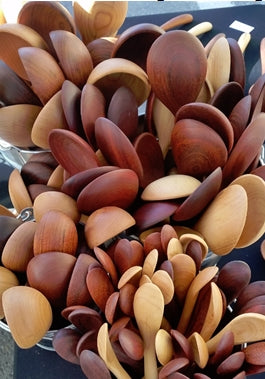
Nowadays, the objects we possess tend to be less “heirloom quality” and more “upgradeable”—and disposable—than they were during Great-Aunt Helga’s childhood. That furniture from Ikea? It looks good right now, but it is probably not going to be passed on to the grandkids. The fishing pole I gave my son (made with aluminum, in China) bent and then broke the season after I bought it.
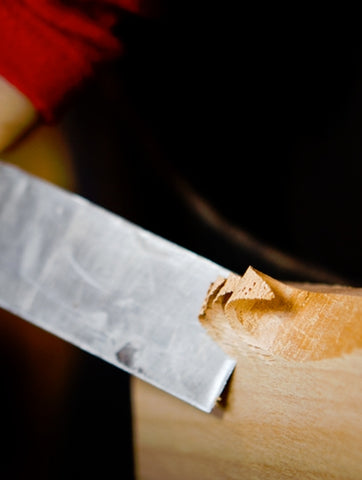
There are exceptions, of course, but when it comes to manufacturing these days, it seems quality takes a backseat to price, convenience and mass production. And then there’s that bewildering concept called “planned obsolescence”—defined by The Economist magazine as “a business strategy in which the obsolescence (the process of becoming obsolete—that is, unfashionable or no longer usable) of a product is planned and built into it from its conception. This is done so that in the future the consumer feels a need to purchase new products and services that the manufacturer brings out as replacements for the old ones.” Think cell phones: if we don’t own the newest, thinnest, most feature-packed model, it’s time to get an upgrade, or so the world says.
As a result of these wild and wacky economic forces, long-lasting, handcrafted goods are harder and harder to come by. And in the process, the word “heirloom” is slowly disappearing from our vocabulary.
That’s where people like Brad come in.
Brad’s hope, he says, is to craft products that his grandchildren will pass on to their grandchildren. And by creating objects that are not only beautiful and useful, but are also durable, Brad helps us recall—and recreate in our own homes—a time when most of our possessions had meaning and purpose…when less of what we owned was disposable. When less of what we owned was “obsolete.”
With all of this in mind, I decided to ask Brad what “heirloom” means to him. This is what he had to say:
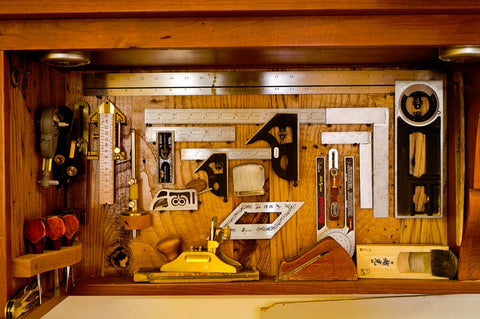
“If you’re not already, picture yourself as the maker or manufacturer of some product. For this product, you can choose anything…a chair, a picture frame, a blender, pen, a dog leash, even a wooden spoon. OK… really pick something. Now, for that product, if the manufacturing process was entirely up to you, you could make the product a number of ways:
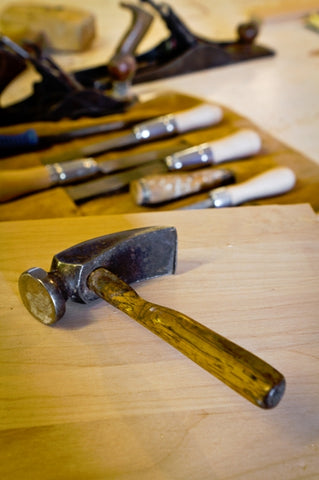
The choice to make heirloom-quality products is about pride in what I do. It’s about confidence in how long the products will last. And it’s about taking that road to a more sustainable, less disposable world and hoping that the importance of the intentional ‘things’—or heirlooms—in our lives will rub off on those who use them.”
--By AA and BB
April 12, 2016 0 Comments
We think a lot about the products we craft. We also think about the origins of the wood we use to create them. We wonder about the forests around the world that supply us with that wood, the mills where those trees are cut and dried, and the people who do the work, from start to finish.
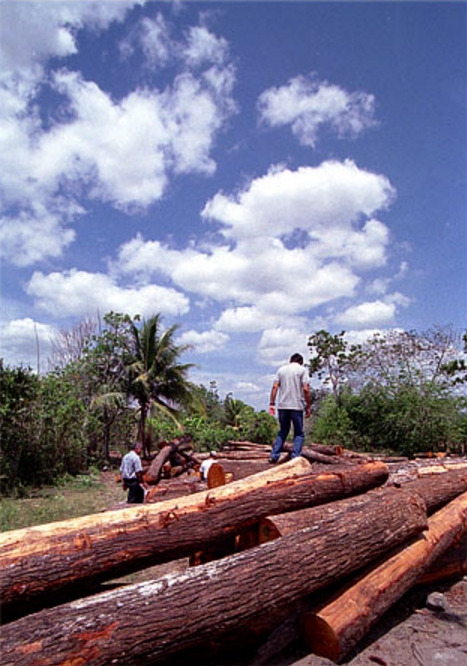
- A millworker walks a stack of logs in Quintana Roo, Mexico. By Mark Stephens.
With the exception of our hard maple, which grows here in the United States, we use tropical hardwoods to make our utensils. Why? Because, true to their name, tropical hardwoods are just that... hard woods. This means they’re durable, and strong—the best woods we could possibly choose to craft tools and cutting boards that will last a lifetime, or longer. We source our tropical hardwoods from a lumber mill called World Timber Corp in North Carolina. The mill’s owner, Joe Steinbach, and his partner, Matt Westmoreland, have high standards. For about six weeks of each year, they travel the world, visiting the sawmills that provide them with lumber and working with the millworkers to cut it to their specifications. Once that lumber makes it to North Carolina, it’s kiln-dried. Brad’s orders—of bloodwood, jatoba and Mexican ebony, mostly—arrive by semi-truck to the Earlywood studio north of Red Lodge. The studio has no loading dock, so Brad uses an engineer’s ingenuity combined with the help of a tree, some chain, a tow strap, and some crossed fingers to unload the freight. (The last delivery weighed about 7,000 pounds, to give you an idea of the task at hand.) Brad then spends the larger part of a day stacking it in the studio. After a good night’s sleep, he begins, once again, to turn those pieces of roughsawn hardwood into beautiful kitchen tools for the rest of us to use and enjoy.

- Some of our products, made from Mexican Ebony
But where does that wood come from, really? Before it’s loaded onto the delivery truck in North Carolina? Where does it grow? How is it harvested and who, for that matter, harvests it?
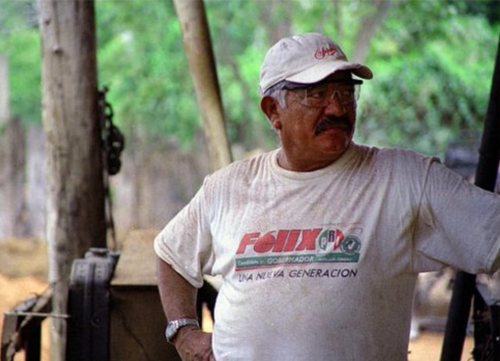
- This guy harvests it! Mill boss, Quintana Roo. By Mark Stephens.
Let’s take a look at Mexican ebony, which we use to make many of our products. Also known as Katalox (pronounced “cat-ah-losh”) and Mexican royal ebony (although it isn’t a true ebony), its scientific name is Swartzia cubensis. Not only is Mexican ebony related to the chickpea, it’s known for being an outstanding “tonewood,” which means it has good tonal properties. Between this and the decline of ebonies traditionally used in the production of stringed instruments, Mexican ebony is becoming a wood of choice for luthiers worldwide. At 3660 on the Janka hardness scale (compared to 480 for our neighborhood pine, the lodgepole, for example), Mexican ebony is strong and tough. This means it’s essentially waterproof and about unbreakable, making it a great choice for kitchen utensils and cutting boards…as well as guitars. Typically dark brown to black with hints of purple and, occasionally, edges of creamy, golden sapwood (the living, outermost part of a tree’s trunk, branch or stem), Mexican ebony is a treat for the eyes. It’s a tropical hardwood. This means, obviously, that it grows in the tropics—in southern Mexico, Central America, and northern South America, specifically.

- The Quintana Roo region of the Yucatan Penninsula (where Earlywood's Katalox is grown
The particular mill that supplies Katalox to World Timber Corp, then to Earlywood is a great example of sustainable forestry. The local community was given a large parcel of forested land by the Country of Mexico. This land is divided into 20 different sections. Only one of the 20 sections can be harvested each year and then, only certain types of trees that are a certain minimum diameter are harvested from that section. This guarantees work and future work for the local people.
Mark Stephens, operations manager at Woodworkers Source in Scottsdale, Arizona, has an interesting perspective on the cutting and milling of tropical hardwoods, including Mexican ebony. About 10 years ago, Mark visited lumber mills in the jungles of Quintana Roo on Mexico’s Yucatán Peninsula.
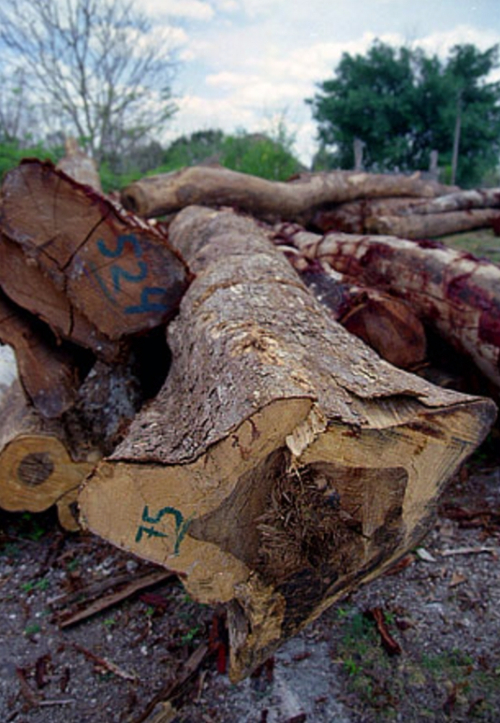
- A Mexican Ebony tree, ready for rough sawing
In his blog post, “Sawmills of the Yucatán”, Mark wrote, “Something I've learned about the exotic wood business is that the woodworking community has little clue as to what goes into producing lumber from trees. The work is immense, and often highly unsafe. On top of it, the work takes place outside in extreme humidity and heat. They don't have luxuries like forklifts to lift bundles of wood at a time, either. We're talking about a lot of heavy, tedious, work-by-hand.”
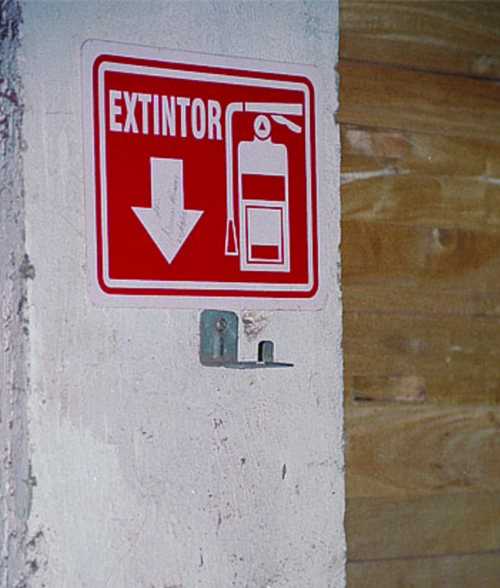
- Safety in the mill Mark visited was not the top priority
Mark’s blog includes an extraordinary selection of photos from his visits to the region’s sawmills and furniture studios. His post also expounds on the notion of selling imported hardwood lumber “as an act of conservation.” It makes for an interesting read, to say the least.
Many thanks to Mark for allowing us to use his photos.
April 03, 2016 0 Comments
Trees surround and support us. They capture carbon, produce oxygen and provide shelter for birds and other wildlife too. They shelter us as well: the floors we walk on, the furniture we sit on, the cabinets that hold our dishes and dry goods, the framing within our homes’ walls, the porches and decks where we enjoy a summer’s afternoon, the instruments that play the music that soothes or stimulates us—objects made from wood are everywhere. The list goes on and on.
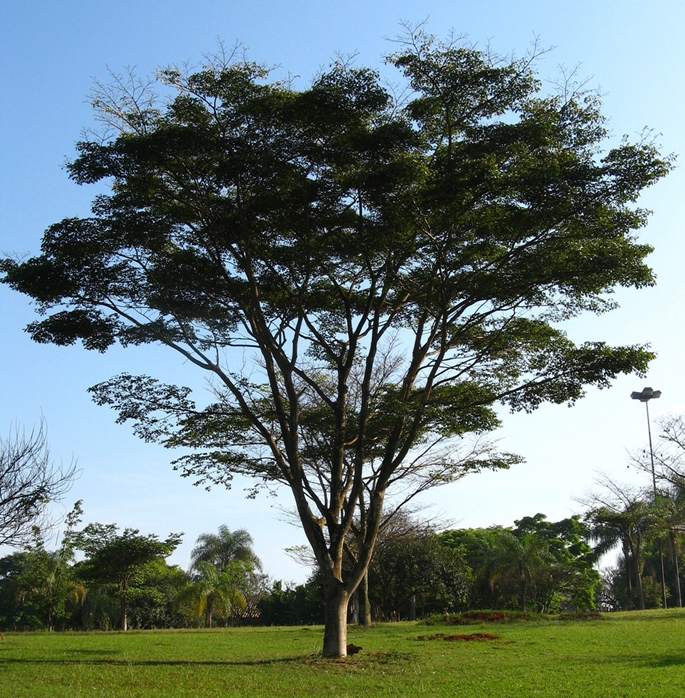 - A young Jatoba tree in a park in Brazil
- A young Jatoba tree in a park in Brazil
It’s no wonder our forests are dwindling. Here in the US, the demand for wood products is climbing at twice the rate of our nation’s population growth.
Worldwide, around 46-58 thousand square miles of forest are lost each year—that’s the equivalent of 48 football fields every minute.
What’s a woodworker to do? To begin with, get a perspective. The greatest cause of deforestation, for example, isn’t the demand for lumber, it’s industrial agriculture. This is particularly true in tropical and subtropical countries where enormous swaths of land are cleared to plant massive mono-crops of soybeans, cotton, maize or palm oil, or to graze cattle. Paper production is another big factor. So is the lumber we use to build our homes and businesses, to craft our furniture and, yes, to make kitchen utensils.

- A small chunk of the Amazon rainforest... in tact.
There’s no way around it. Being human, especially in the developed world, typically means leaving a rather large ecological footprint. But whether your kitchen tools are made of wood or another material, they have an impact, as Brad so eloquently wrote on Earlywood’s “Sustainability Policy”
While we’re not excusing ourselves for our lumber use here at Earlywood, we’re trying to put it into perspective. No matter how simply we live, there are certain tools we need, others we may not exactly need, but nevertheless enjoy…and there’s a certain joy that comes with using a well-made tool, especially when you realize that Brad has devised a way to give back to the planet that has so generously given to him.

- A LOT of tree seedlings being nursed before they head to the Atlantic Rainforest
For about 3 years now, Brad has worked with The Nature Conservancy’s Plant a Billion program to plant 100 trees for every one tree he uses at Earlywood. The best woods for our uses don’t grow here in the US, Brad tells me. They grow in tropical climates. So that’s the region Brad has chosen to target through the Conservancy’s reforestation program, specifically Brazil’s endangered Atlantic and Cerrado forests. One of the most biodiverse ecosystems in the world, the Atlantic Forest is also one of the most threatened, due mostly to ranching, industrial agriculture and urban expansion. Home to more than 10,000 plant species and over 1,300 vertebrates, the Cerrado Forest is also under threat. With help from people like Brad, The Nature Conservancy is working to promote large-scale restoration in both of these forests.
Recently, Brad decided to up the ante. Rather than donate 100 trees for every one tree used at Earlywood, Brad will donate $1 to the Nature Conservancy’s reforestation program from every order placed! Whether it’s an order for 100 items or just one, Brad will give a dollar to help “plant a billion” trees in Brazil. That’s a lot more trees than he was planting before.
This new program starts TODAY and we will have a page up on our website that tracks our progress. We'll be in touch when that goes live.
 - A patch of Amazon rainforest cleared for other uses.
- A patch of Amazon rainforest cleared for other uses.
Earlywood is a tiny business compared to many, and one could say the environmental efforts Brad makes are just a drop in the proverbial bucket. But, as wise old Aesop once said, “No act of kindness, however small, is ever wasted.” I would venture to add that no act of environmental stewardship is wasted, either. So, as you’re serving up this venison stew with your Earlywood long server or using your flat sauté to cook up some of these morels, you might think about those forests in Brazil and give yourself a pat on the back for helping to replant them. For by purchasing from Earlywood, you do just that.
- AA and BB
March 24, 2016 0 Comments
Most of you know that Brad Bernhart is the founder of Earlywood. But how many of you actually know the man who crafts what he hopes are your most indispensable kitchen tools? To shed a little light on Brad—and Earlywood—we thought we’d take some time to talk to him. For insight on the company’s early beginnings to the satisfaction and inspiration that keep Brad making the tools we love, read on!

- The Bernhart Fam-dam
What inspired you to start Earlywood?
Two categories of things inspired me. First, the things I want to do: be creative, work with my hands, start a business, be challenged, be my own boss, have a flexible schedule, spend time with my wife and kids, live in Montana. And, the things I don’t want to do: commute, work a desk job, answer to other people, sit, know exactly what the next 10 years will be like, live away from my family, work hard and make more money for someone else than I make for myself, regret not going for it!
Why kitchen utensils?
I have always loved wooden spoons. Every time I go to a friend’s house, the first thing I do is check out their utensil selection. There can be so much history in them. It’s common to hear, “that was my grandma’s,” or “that was my great-grandma’s!” Kitchen tools become so loved by those who use them daily, and I love thinking that I could be creating family heirlooms. Also, being a mechanical design engineer, I think I have a unique way of looking at utensil designs. That’s why a lot of my designs are so functional, even though they might not look like a “typical” wooden spoon.
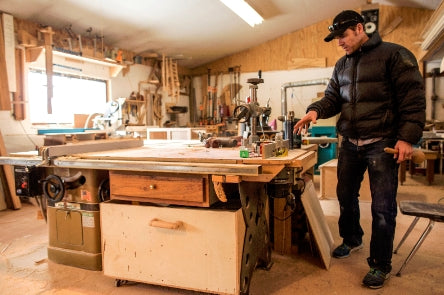
- Inside the Earlywood Shop
There’s a story behind the Earlywood name. Can you recap that?
Myself, my wife, and a good friend were tossing names around one day over a few beers in Portland, Oregon. The name “Earlywood” came up and I liked it. After some research, it seemed pretty obvious that it was the one.
What does the word mean?
Earlywood is the light-colored portion of a tree’s annual growth ring. It’s the part of the ring that grows early in the growing season—in the spring and summer—and it’s the part of the tree that’s responsible for delivering water to the rest of the tree. Because it grows quickly, during those wet, sunny months, it usually makes up the bulk of the tree’s mass.
What inspires you?
Clean design, efficiency, heirloom quality, creating, challenges.
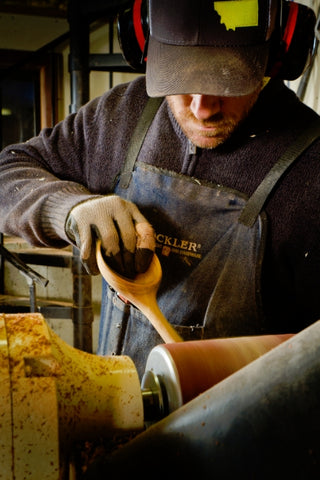
- Final shaping of a ladle handle
Among your customers is there a hands-down, all-time-favorite Earlywood tool? If so, which is it?
Definitely. The Trifecta, which is a three-piece combo. The three tools together take care of 90% of the jobs you’ll ever need to do in your kitchen. I just checked yesterday and the Trifecta has 38 reviews on my website and every single one of them is a five-out-of-five star review!
How about you? Do you have a favorite Earlywood tool?
For sure. My favorite is the longest tool in The Trifecta. It’s called the “Large Flat Sauté.” I have 12 of them in my kitchen at all times. At craft fairs, when people see it, they usually ask what it’s for. If they buy one, they inevitably come back the next year and go on and on about how much they love it. And that’s when they buy 10 more for all of their friends!
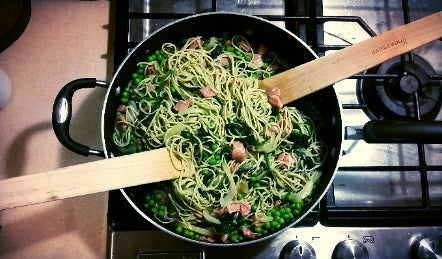
- Two of my favorite Earlywood tools (L Flat Sautes) in action
What keeps you going?
I love showing up at my shop in the morning with a full day of hard, creative, honest work ahead of me. It's a very fulfilling and satisfying feeling. It may be very 1950's USA of me to think this way, but it makes me feel like I’m really doing something good for myself, my family, my community, my state, and for the country in some small way. I’m sure that feeling will grow when I start employing people and helping them support their families too.
What do you like most about your job?
I love seeing how many people are really loving Earlywood. Creating a product, then taking the chance of making and selling that product to the general public is similar to starting a new relationship. There’s the chance that your new idea or product won't be accepted. That leaves you feeling pretty vulnerable. When it all works out and people reach out to you specifically to tell you that they love your stuff and that they are trying to get all of their friends into it, it feels damn good though!

-Red Lodge, Montana. The home of Earlywood.
You’ve told me you listen to podcasts while you work. Tell us one of your favorites.
There are so many great ones out there and I listen to about 20 of them. If I had to pick one though (that wasn't e-commerce related), then it would be “Reply All” from Gimlet Media. It's two guys who tell great This American Life-like stories that all relate in some way to how the Internet has and does affect us and our lives. It’s nonfiction, seriously entertaining, and highly recommended by me!
“When I grow up, I want to be...” When you were a kid, what did you want to grow up to become? Did you imagine you’d be making kitchen utensils?
I definitely wanted to be a helicopter skiing guide in Canada! Actually...I would still take that job! I was ALL ABOUT skiing as a kid. I even moved to Jackson Hole, Wyoming for four years after high school so I could ski as much as possible. I never thought I would be making kitchen utensils. If you had come to me when I was 12 years old and told me what the future had in store, I wouldn’t have believed you.

- Our backyard... the Beartooth Pass
What’s your vision for Earlywood’s future?
Excellent question. Earlywood is teetering on the edge of becoming more than a one-person show with a bit of temp help here or there. And this is something that my wife Charlotte and I need to sit down and discuss. It’s so easy to say, “I want it to be bigger,” but I don’t want the business to grow just for the sake of growing. I want Earlywood to be a great compliment to my life. I don’t want it to define my life.
If you could make anything, absolutely anything—and I don’t mean just kitchenware, what would that be?
Something else that is made of wood and small and can easily become a family heirloom...blocks for kids!
- Written by Lexy Adams
February 18, 2016 0 Comments


February 10, 2015 0 Comments
Did your Earlywood utensils see some heavy use this holiday season? Or maybe you received them as a Christmas gift and you’ve used them every day since? Either way, we hope you have been putting them to good use. If so, they could probably use a little TLC by now. Here are tips to deep clean wooden spoons and reapply oil. Here’s what we suggest:
General tips:
 The first thing to remember is that water is not a friend of wood. It can cause your utensils to swell, warp, fade, and crack. To prevent this, hand wash your utensils with hot soapy water and dry in a rack. The wash cycles in a dishwasher are too long and those hi-temp drying cycles don’t help either. They soak up water, then dry out but don’t get scrubbed. This will make sure that your utensils turn gray, fuzzy and live a short life.
The first thing to remember is that water is not a friend of wood. It can cause your utensils to swell, warp, fade, and crack. To prevent this, hand wash your utensils with hot soapy water and dry in a rack. The wash cycles in a dishwasher are too long and those hi-temp drying cycles don’t help either. They soak up water, then dry out but don’t get scrubbed. This will make sure that your utensils turn gray, fuzzy and live a short life.
Scrubbing:
 After the first few times you used your utensils, you may have noticed your spoons looking or feeling a little fuzzy. That’s to be expected as the grain of the wood is raised by exposure to water. If that hasn’t worn off by now, rub your DRY utensils with a Scotch-Brite pad. Use the little purple one you got with your purchase or the scratchy green side of your dish sponge. A one-time scrub will remove the fuzz for life. Keep the pad; it can be used again and again on your other wooden items.
After the first few times you used your utensils, you may have noticed your spoons looking or feeling a little fuzzy. That’s to be expected as the grain of the wood is raised by exposure to water. If that hasn’t worn off by now, rub your DRY utensils with a Scotch-Brite pad. Use the little purple one you got with your purchase or the scratchy green side of your dish sponge. A one-time scrub will remove the fuzz for life. Keep the pad; it can be used again and again on your other wooden items.
Oil:
 Every once in awhile, give your utensils a good coat of oil. We prefer mineral oil, because it is food safe, has no scent, never goes rancid and soaks in quickly. The oil will repel water and thus reduce the number of times your utensils go through the wet/dry cycle. This will prevent warping, fading and cracking that can be caused by repeated exposure to water. Give them every bit of oil they will soak up. It’s a good idea to put on as much as you can, then let them sit overnight before drying extra off with a towel to make sure they soak up every last drop.
Every once in awhile, give your utensils a good coat of oil. We prefer mineral oil, because it is food safe, has no scent, never goes rancid and soaks in quickly. The oil will repel water and thus reduce the number of times your utensils go through the wet/dry cycle. This will prevent warping, fading and cracking that can be caused by repeated exposure to water. Give them every bit of oil they will soak up. It’s a good idea to put on as much as you can, then let them sit overnight before drying extra off with a towel to make sure they soak up every last drop.
In our opinion, oiling wooden spoons is one of life’s simple pleasures. It’s akin to waterproofing a good pair of hiking boots or a good pair of leather gloves. Take your time and enjoy it! If you want to keep your Earlywood utensils in like-new condition, oil them every 5-6 uses, but if you’re a fan of that well-used look (like we are), then you can oil them every 3-6 months.
For more details on wood care, check out our Wood Care or our FAQ page.
If you are still left with unanswered questions, please ask us via email, info@earlywooddesigns.com.
August 13, 2014 0 Comments




December 11, 2012 0 Comments

One step in the design process here at Earlywood is to define how and why traditional wooden spoons fall short when it comes to many common cooking tasks. Once the downfall is identified, the next step is to design a tool that will excel at that task, while maintaining a form that is pleasing to the eye and comfortable in the hand. The reasonably priced Trifecta is the result of three such iterations of our design process. It scrapes, spreads, and stirs better than any traditional wooden spoon can.
- The L Flat Sauté wooden spatula is perfect for stirring nearly everything we cook. At 13" long, it allows the cook's hand to be kept far from the heat and provide more projected surface area (pardon the specifics, but I am a mechanical engineer after all) than a regular wooden spoon, so they mix up your dinners quicker and more efficiently. The radius at the front corner of the Large Flat Sauté is also smaller than that of a regular bowled wooden spoon, thus allowing you to get into those previously unreachable tight pan corners.
- The Tera Scraper, with a angled front edge is designed to remove the stubborn, yet tasty morsels of food stuck to the bottom of your pan. Ever tried scraping polenta or salmon off the bottom of a cast-iron pan with a regular wooden spoon? What takes 50 scrapes with a spoon, will take five with the wide path of the Tera Scraper.
- The third musketeer, the Spreader, makes easy work of spreading thick dips, cutting cheeses, and handling all other spreadables from hummus and brie to peanut butter and jelly. All tasks which are pointless to even try with a traditional wooden spoon.
We are told over and over again by customers that these are the first tools they reach for when they begin to cook. You know, they’re our favorites too.
You save $1 each when these three are bought as the Trifecta and they were Earlywood’s best seller last year. Even in our enthusiasm to release the ladle and servers last month, we wanted to be sure to remind you about these handy and hardworking utensils. Judging by our success at the MADE Fair in Missoula, Montana last weekend, we're wondering if the reminder is even necessary.
We sell sets (with the $1 off each piece discount) of Flat sautés and spreaders in an assortment of sizes and wood types. Of course, they are always available here on our website.
Happy Holidays from us!
December 05, 2012 0 Comments
What is earlywood?
Do you remember the last time you looked at a cross section of a tree and counted the growth rings? What you were really doing is counting how many times the earlywood/latewood cycle has taken place. Each year, every tree adds a ring of earlywood cells and a ring of latewood cells. These rings tell the age of the tree and a lot more. The thickness of the rings tells how favorable growing conditions were that year. You can count your way back through the rings of a tree and pick out the nicest summers and the harshest winters. You can also count the rings across the end of an Earlywood spoon and see how long it took to grow that spoon.

Earlywood develops in the spring when rain and nutrients from the soil are abundant and days are getting long. New growth makes up the better part of the ring, and in many woods, it is lighter in color than latewood, which develops towards the end of summer before the tree goes dormant (in harsh climates). Of course, growth rings can vary drastically in appearance between a tree that was grown in Canada and a tree that grew in Brazil.
Earlywood is porous, and made up of thin walled cells, compared to latewood, which is influenced by colder temperatures and drier conditions. As a result, latewood is made of densely-layered, strong, thick-walled cells. Both earlywood and latewood serve a purpose for the tree. It’s the latewood that gives wood the majority of its strength, and the earlywood keeps the tree growing by delivering water and nutrients.
What is Earlywood?
In that spirit of renewal and growth of spring that gives earlywood the chance to grow, we have created the Earlywood kitchen utensil product line. We've taken the common form – a simple spoon – to an uncommon level of quality in function and beauty. Spoons have been around for thousands of years, but that doesn’t mean anything other than that they have been around for thousands of years. I use my background in design/mechanical engineering to analyze every single aspect of the spoon and its purpose. No detail is too small to change if it makes the utensil better. I often start with a specific task in mind and design a utensil that fulfills the need. It is an iterative process and I commonly reference this Buckminster Fuller quote for inspiration and a reality check.
“When I am working on a problem, I never think about beauty but when I have finished, if the solution is not beautiful, I know it is wrong.”
This is why all Earlywood utensils are both utilitarian and beautiful. So that is Earlywood from a design and product standpoint, but Earlywood means a lot more for us. Earlywood is also a way of life. It’s a way to feel good about using a sustainable resource to create beautiful objects that can be passed on through generations. It’s an excuse to spend time in the shop working with our hands. It’s a way to stay creative. It’s a small business and is a way to connect with and give back to our local community. Earlywood is first in quality, and we will maintain that as long as we are able to wake up and make it to the shop. Like us on Facebook so you don’t miss out and follow us on Instagram @earlywood_designs.com. You can also sign up for our newsletter, so you never miss out on our next big idea!


